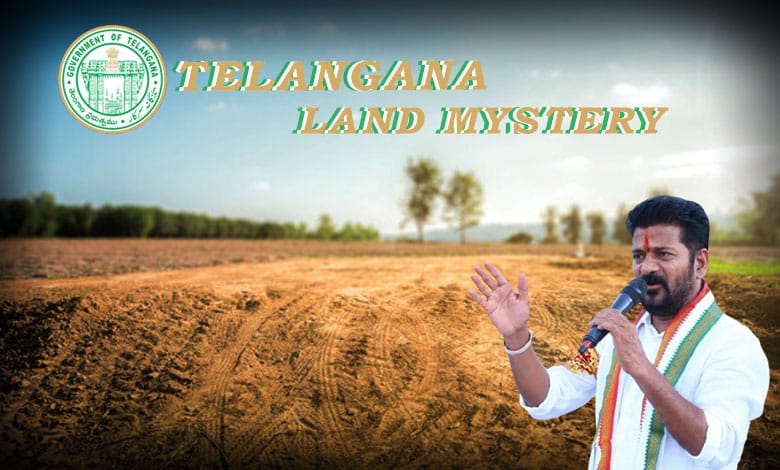Telangana Land Mystery: Records Show 8-Lakh Extra Acres That Don’t Exist – What Went Wrong?
Telangana's land records reveal an 8-lakh-acre discrepancy between Sethwar and Dharani digital records. Authorities are investigating the cause of the anomaly, which includes non-existent lands and errors in survey data.

Hyderabad: In a significant development in Telangana’s land administration, a massive gap of nearly eight lakh acres has been uncovered between the traditional Sethwar land records and the newly implemented Dharani digital land records.
This discrepancy has raised serious concerns among state officials, prompting the Revenue Department to take corrective measures.
The efforts come as part of the ongoing transition from the Dharani portal to the new Bhu Bharati portal, aimed at streamlining and improving land record management in the state.
Table of Contents
The Gap: 8 Lakh Acres Between Sethwar and Dharani Land Records
The discrepancies between the Sethwar records and the Dharani digital records have raised alarms due to the significant gap of approximately 8 lakh acres. Initially, the Sethwar records, the traditional and historically relied upon land registry in Telangana, indicate a total land area of 26.98 lakh acres under base survey numbers.
However, the Dharani records, which were digitized and made available in 2016, list a much higher figure of 32.80 lakh acres—showing an excess of nearly six lakh acres.
This discrepancy was traced to the creation of bi-survey numbers, a system in which additional survey numbers were assigned to base survey numbers without any corresponding actual land, leading to inflated land areas in the Dharani records.
Revenue department officials are working meticulously to resolve this issue, starting by eliminating the bi-survey numbers that are linked to non-existent lands in the base survey numbers.
Progress and Current Measures
To date, the revenue department has managed to address discrepancies in two lakh acres by deleting the excess and non-existent bi-survey numbers. However, the work is far from over, with six lakh acres still under review and being corrected.
The current efforts are focused on reconciling the remaining discrepancies, which mainly stem from land parcels that were incorrectly mapped under the Dharani records.
Districts such as Asifabad, Mulugu, Rangareddy, Medchal-Malkajgiri, and Sangareddy have been identified as the most affected, with Asifabad bearing the brunt of the discrepancies—about 90,000 acres are reported to be incorrectly listed in the Dharani records.
Other districts such as Mulugu, Rangareddy, and Medchal-Malkajgiri also show significant discrepancies, ranging from 16,000 acres to 34,000 acres.
To resolve these anomalies, Telangana officials are meticulously cross verifying the digital records from Dharani with the traditional Sethwar records, also known as the Resurvey Settlement Register of 1956, in an effort to restore the accuracy of land data.
This process is expected to continue for several months as officials work through the complex web of land records to ensure that the final records reflect the actual land ownership and extent.
The New Bhu Bharati Portal and the Telangana Bhu Bharati Act, 2024
In December 2023, the Congress government approved the Telangana Bhu Bharati (Record of Rights) Act, 2024, which aims to replace the current Dharani portal.
The Bhu Bharati portal is expected to be more reliable and accurate in terms of land records, offering a more comprehensive and up-to-date registry for the state’s landowners and farmers.
The Bhu Bharati portal will be the successor to the Dharani portal, which has faced criticism for inaccuracies and lack of proper field-level verification.
The new portal is slated to go live in March 2025, once the guidelines for its operation are fully drafted and approved by the Telangana government. These changes are expected to offer a more transparent and efficient system for managing land records in the state.
Challenges with the Dharani Portal: Data Inaccuracies and Financial Losses
The main issue with the Dharani portal lies in its reliance on outdated data from surveys conducted during the Nizam era in the 1930s. The portal’s records were uploaded in 2016 without taking into account subsequent changes in land ownership, boundaries, or developments.
Additionally, the creation of multiple bi-survey numbers for land parcels that exceeded the original base survey numbers led to a misrepresentation of land area.
This digital mismatch has caused widespread problems, ranging from disputes over land ownership to incorrect land records, affecting farmers and landowners across Telangana. The inaccuracies also had serious financial implications.
Many farmers, based on erroneous land records, received benefits from government schemes like Rythu Bandhu, Rythu Bima, crop loan waivers, and Rythu Bharosa—programs aimed at supporting farmers.
However, these benefits, which amounted to thousands of crores of rupees, were provided to landowners of non-existent agricultural lands due to the inaccuracies in the Dharani records. As a result, the state exchequer has faced huge financial losses.
Moving Forward: The Path to Accurate Land Records
The Telangana government is now taking corrective action to resolve these issues and ensure the new Bhu Bharati portal reflects accurate land records.
Officials are working on rectifying discrepancies by comparing the Dharani digital records with the Sethwar records, which are the foundation of land management in Telangana.
The Sethwar (also known as the A Register) is a comprehensive land registry that includes details such as land type (Inam, government, poramboke), survey numbers, ownership, soil type, and sources of irrigation.
These records, which were initially created during the land survey process between 1936 and 1956, remain the foundational documents for land ownership in Telangana. By aligning the new digital records with the Sethwar records, the government hopes to create a more accurate and reliable database for farmers, stakeholders, and landowners across the state.
